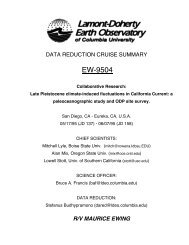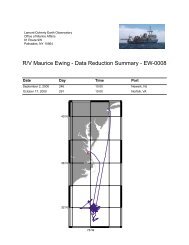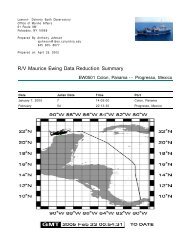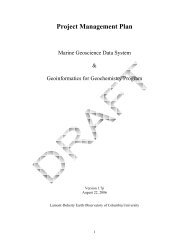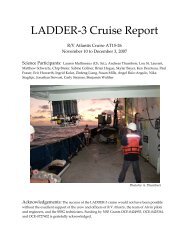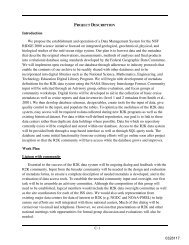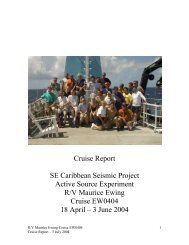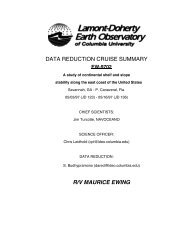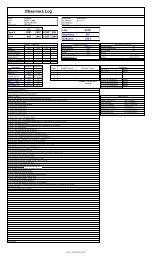NBP09-01 Cruise Report - British Oceanographic Data Centre
NBP09-01 Cruise Report - British Oceanographic Data Centre
NBP09-01 Cruise Report - British Oceanographic Data Centre
- No tags were found...
Create successful ePaper yourself
Turn your PDF publications into a flip-book with our unique Google optimized e-Paper software.
Seasonal sea ice changes in the Amundsen Sea appear to be more pronounced in spring, when the winddrivensea ice retreat can be up to 80 days earlier (whereas changes in the Bellingshausen Sea are morepronounced in autumn). An early retreat in the Amundsen Sea is usually followed by a later advance,though the magnitude of the advance anomaly is usually half that of the retreat anomaly (e.g. 40 versus 80days, respectively).Within this backdrop of Southern Ocean sea ice change, little is known about the snow and sea ice thicknessdistributions, the processes that control it, or the role that snow and summer surface melt processes play inthe persistence of the sea ice cover. This is particularly true in the Amundsen and western BellingshausenSeas which have until now been largely unsampled. Yet this region has some of the highest snow accumulationrates in the Antarctic. This deep snow cover plays a complex role in the sea ice mass balance through meltand refreezing and conversion of snow to ice through sea water flooding. These processes have implications forhow summer sea ice will respond to climate change, play a vital role in the structuring of sea ice ecosystemsin porous gap layers in the ice, and complicate satellite retrievals of snow and ice thickness. A major aim ofsea ice activities on <strong>NBP09</strong><strong>01</strong> was to better understand how these processes control sea ice mass balance.Within this context, sea ice studies on <strong>NBP09</strong><strong>01</strong> focused on assessing the properties of summer sea ice inthe Amundsen Sea (extent, thickness, growth/melt history, snow fraction, deformation and drift). Below inSection 5.2 we give an overview of our sampling approach and discuss general findings. In Section 5.3 wegive a more detailed description of methodology of our three main activities - shipboard observations of iceconditions, a sea ice sampling program, and deployment of instrumentation in the ice. In this section, wealso describe the various caveats of our approach, with emphasis on how it might be modified and improvedfor future missions.5.2 Overview of Sampling Approach and Initial FindingsDuring <strong>NBP09</strong><strong>01</strong> we made 197 underway hourly observations during approximately 13 full days in sea ice,held 20 sea ice stations and collected 92 meters of sea ice cores. Our stations and samples were distributedalong north-south and east-west transects in the region of the summer pack ice (Figure 24). The totalamount of ice core retrieved for structural analysis alone exceeded 52 m - comparable to totals obtained ondedicated sea ice cruises, but a record relative to total length of the sea ice team (3.6m). This is of particularsignificance, as sea ice physical properties have not been previously examined here. In all, the number ofsummer sea ice cores taken in the data-sparse Amundsen Sea has been more than doubled. We also deployed3 sea ice mass balance buoys which continue to dutifully phone home to tell us where they are and thatthey’re doing fine. These will for the first time allow continuous monitoring of multiyear snow and sea icesurface processes throughout the year. Combined with structural information from the ice cores and processmodelling, these data will help us understand the role these processes play in evolution of the sea ice coverand how these processes might modulate the response of sea ice to climate variability.Mean sea ice thickness of cores collected was 159 cm and ranged from 29 to 469 cm, while mean sea icethickness of the level ice observed while underway was 164 cm. However, both approaches (discrete sea icesampling and underway observations) were biased towards thinner ice, e.g. the ice team avoided samplingridges while the ship avoided navigating in heavy pack ice (e.g. Figure 25). (These caveats are discussedmore fully in Section 5.3.) We note however that the majority of floes sampled were flooded and deformed,and 9% of the surface ice area observed underway was ridged (yielding an estimated ridged thickness of 228cm).By week 6 (Feb 10 to 16), signs of autumn came with the appearance of grease ice and nilas within the icepack. Ice that survived the summer was either thick multiyear ice advected from the western Bellingshausennorth of Thurston Island, or heavily deformed first year ice that generally predominated the summer packice. Overall, the modest thickness of level ice (averaging less than two meters) was consistent with the verylow ice extent that occurred in the summer of 2007.Overall, there are two features which appear to play an important role in the persistence of summer sea ice<strong>NBP09</strong>-<strong>01</strong> <strong>Cruise</strong> <strong>Report</strong> (p. 33 of 83) Revised February 27, 2009



